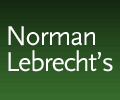To Clap Or Not To Clap by Sarah Choukah Tuesday, October 22, 2002
The concert is eagerly awaited. The musicians have been
rehearsing for months. The hall is an acoustic gem. The music lover is seated
comfortably, completely absorbed in the performance. But now what happens?
Between two sections of Debussy''s Images a patter of clapping breaks out.
The pianist doesn''t move, focuses on the next section, then begins to play. The
music lover pulls a face in the dark. Two hands clapping are enough to break his
concentration and the expected pleasure of the next movement. Not everyone is
aware of the convention, and one wonders why clapping between movements has
become a forbidden act.
 The de rigueur decorum of today''s classical music concerts
wasn''t always so respected. In the first half of the eighteenth century, music
was still a background feature of court banquets and church services. It wasn''t
until the advent of Philidor''s Concerts spirituels, inaugurated during the
French regency period in 1725, that the change gradually began and instrumental
music took on the role familiar to us. The sonatas and concertos of Corelli and
Vivaldi began to be appreciated by the French, and the fanatic admiration of
vocalists faded away, to the benefit of composers and instrumentalists.
Audiences quietened down, behaving as though they were in chapel, and only
clapped once the performance was over. The de rigueur decorum of today''s classical music concerts
wasn''t always so respected. In the first half of the eighteenth century, music
was still a background feature of court banquets and church services. It wasn''t
until the advent of Philidor''s Concerts spirituels, inaugurated during the
French regency period in 1725, that the change gradually began and instrumental
music took on the role familiar to us. The sonatas and concertos of Corelli and
Vivaldi began to be appreciated by the French, and the fanatic admiration of
vocalists faded away, to the benefit of composers and instrumentalists.
Audiences quietened down, behaving as though they were in chapel, and only
clapped once the performance was over.
It wasn''t until Beethoven that the sonata acquired a
revolutionary form and depth of expression that profoundly affected the public''s
reaction. Now the sonata was a seamless composition, with interdependent
movements, not isolated themes, as in dance suites. Above all, the great
Viennese master demanded more of his audience than any previous composer. His
music struck a universal chord, transcending simple harmony to become a profound
internal language. Beethoven demanded the greatest attention from audiences,
asking for a concentration that was exceptional for the period. In this way,
music became a high art with new meaning in the minds of the public.
Along with the need for audiences to concentrate more,
silence became necessary in order to appreciate the music''s continual flow.
Every note was important, harmony had to be fully heard, and the audience was
invited to feel the more complex emotions inherent in Romanticism. "The pause
between movements is a link between them," says conductor and composer Steward
Grant. "It underlines the cohesion between their signature keys. Brahms used
this pause with particular care. In his work it emphasizes the relationship
between the key at the end of a movement and the key at the beginning of the
next in a way that is just as important the music itself."
Silence is a moment for reflection, as much for the composer
as for the performer. It takes months of practice, embarking on this moment of
silence and mentally preparing for the music to come, assuming that there is a
special relationship between sound and its absence that is shared by the
audience. The pause is an invitation to the listener to follow what is to come
and sharpens awareness of the differences between parts of the sonata or
symphony. Between two movements, this silence becomes a moment of meditation on
the conclusion just heard and on its foreshadowing of the next.
To clap between movements can mean many things. The audience
may be moved to the point of wanting the performer to know it, something that
doesn''t displease the musician, nor the composer who is attending the first
performance of his or her music. "I''m already very grateful to people who take
the trouble to come and hear my music," says composer Denis Gougeon. He isn''t
bothered by people clapping between movements. "In fact, I''m filled with joy
when they applaud in the middle of a piece. It means that my composition has
pleased them so much that they want to express their feelings right away. It''s a
rare occurrence."
Composer Jacques Desjardins feels the same. "The current
form of contemporary music is to have pieces lasting from about ten to fifteen
minutes. Some composers don''t do this, but in general movements that follow one
another are much more rare than in the eighteenth or nineteenth centuries.
However, silence has a special function in contemporary music, and is an element
of expression just like the music itself. Some audiences may have a different
perception of what seems obvious to us as composers and may applaud between
movements or think the piece is finished when it isn''t. It depends: audiences
are never made up of the same people. The venue, the style of music, the
performers, the country, and the cultural background of audiences are all
variables in how an audience reacts. But you learn a lot from experiencing
different audiences. My work wouldn''t be the same without them."
Audiences vary mainly on the basis of their nationality and
cultural background. Myriam Pellerin, first violin for the Montreal Symphony
Orchestra, has toured widely and can testify to the differences from one country
to another. "In Japan people are very respectful and clap endlessly. I remember
a concert where Maestro Charles Dutoit took eighteen bows. The applause was very
rhythmic, not wildly enthusiastic. In Europe, audiences are generally more
musically educated than in North America. Classical music is more part of daily
life and schooling, and many people love it. The audience has a more critical
approach and listens attentively. However, Latin countries have numerous venues
where the audience often has its say before the end of the performance. In South
America, for example, people don''t wait to show their disapproval or, on the
other hand, applaud spontaneously and generously when they are
touched."
Quebecers are also quick to clap, but musicians are very
clear about how they feel. Rosaline Blain, founding member of the Lamalgamme
Ensemble, says that performers must behave in a way that shows when clapping is
out of place, and that it''s up to them to preserve an attitude of concentration
during a pause equal to that while playing. Excessive stiffness, however, can
discourage some music lovers who may fear feeling uncomfortable. One has to
remember the importance of the audience''s role. The aim is not to ask more of
audiences, but to guide their concentration so that they may appreciate the work
and find, in silence, a new music.
Guide for the perfect clapper
Clapping can be distinctive, just as much as the timbre of a
voice or the colour of a pair of eyes. No two people have exactly the same
hands. However, there is an appropriate way of clapping that can allow music
lovers to communicate their appreciation much more effectively. It is important
to arch the palm of the right hand and curve the fingers of the left (or the
reverse for left-handed people). This space created by the right hand allows for
greater resonance generated by the fingers and upper left palm, resulting in a
rich sound.
Happy clapping! p
[Translated by Jane
Brierley]
| |



